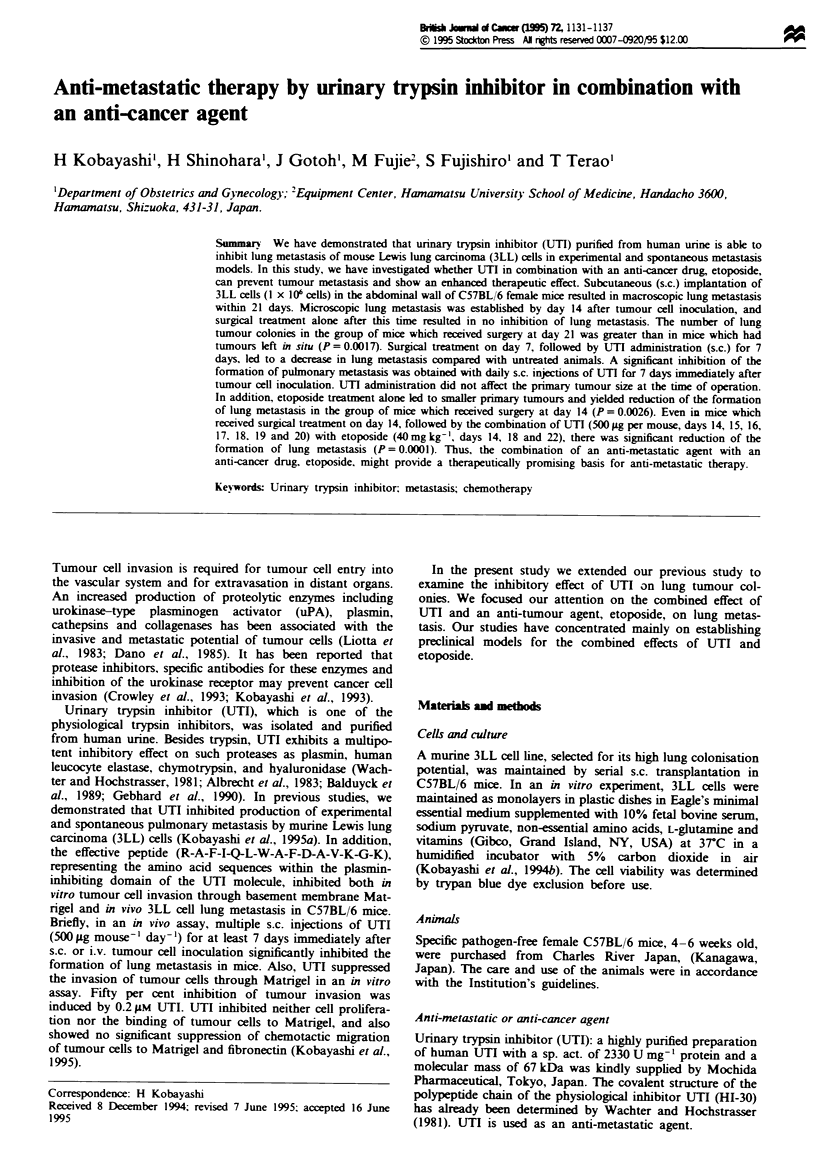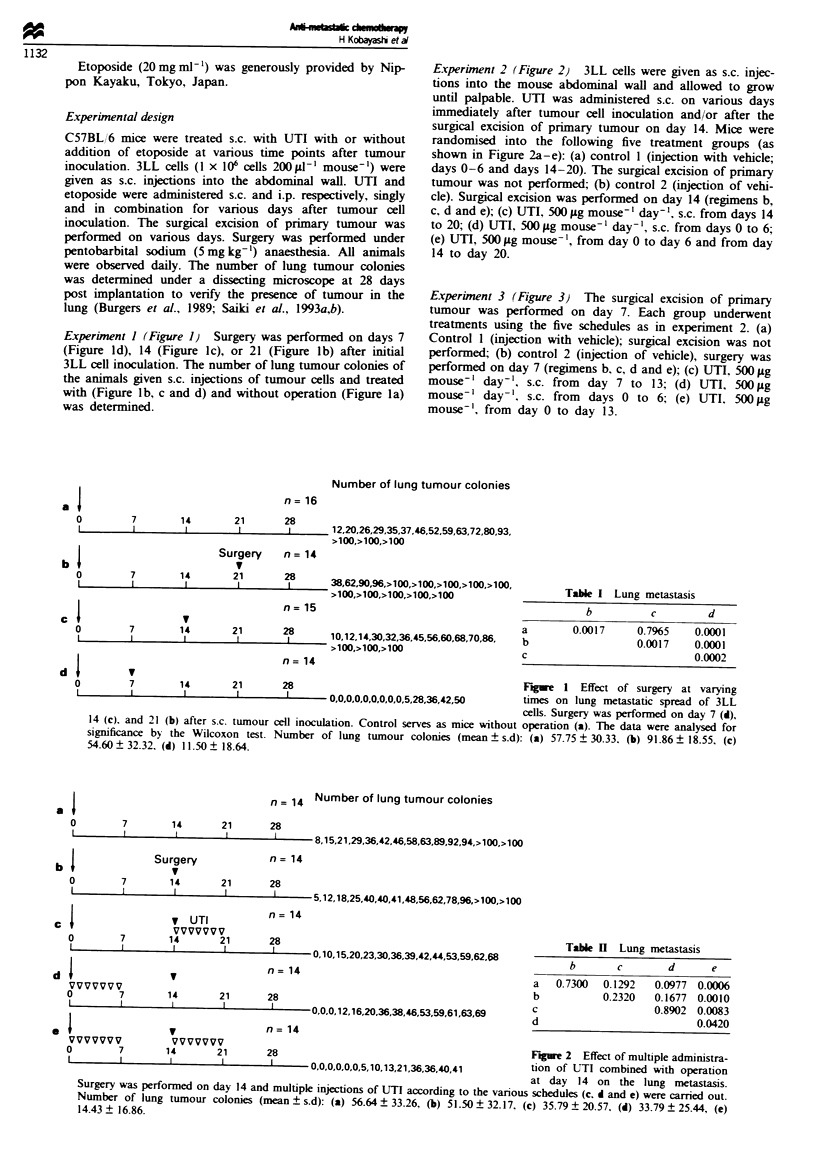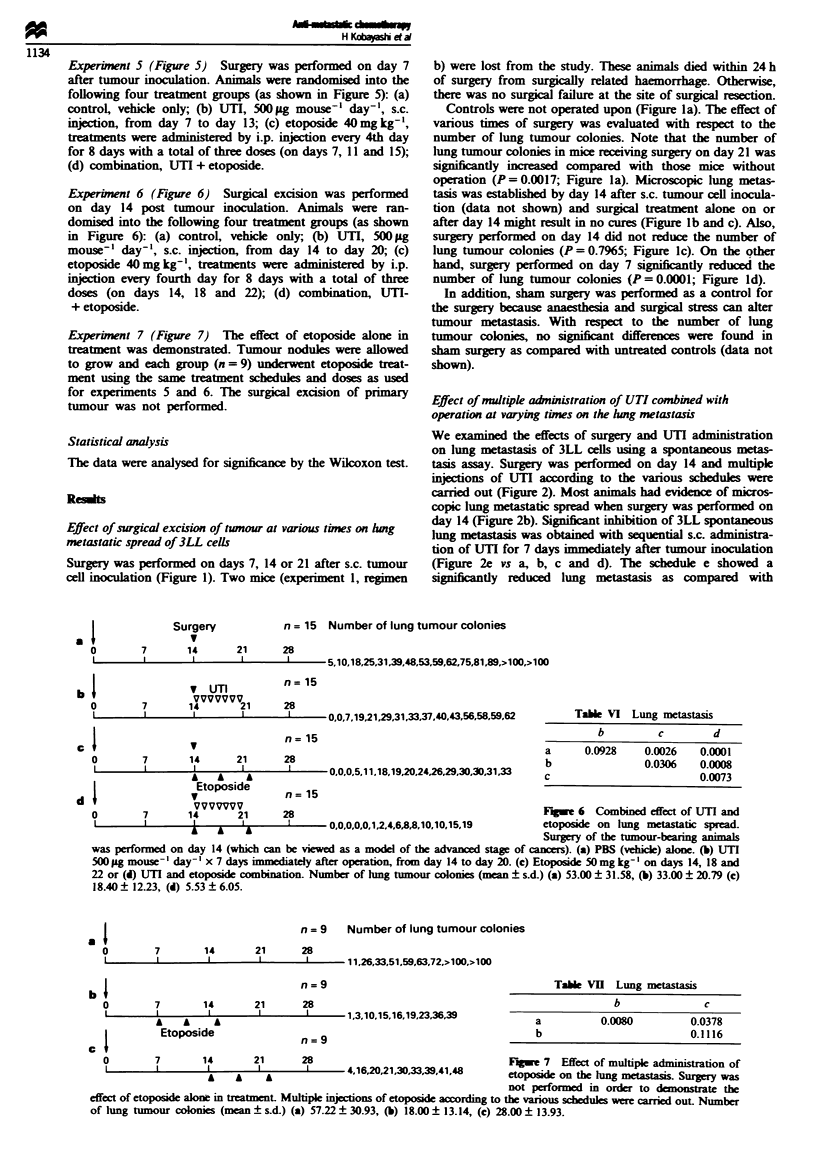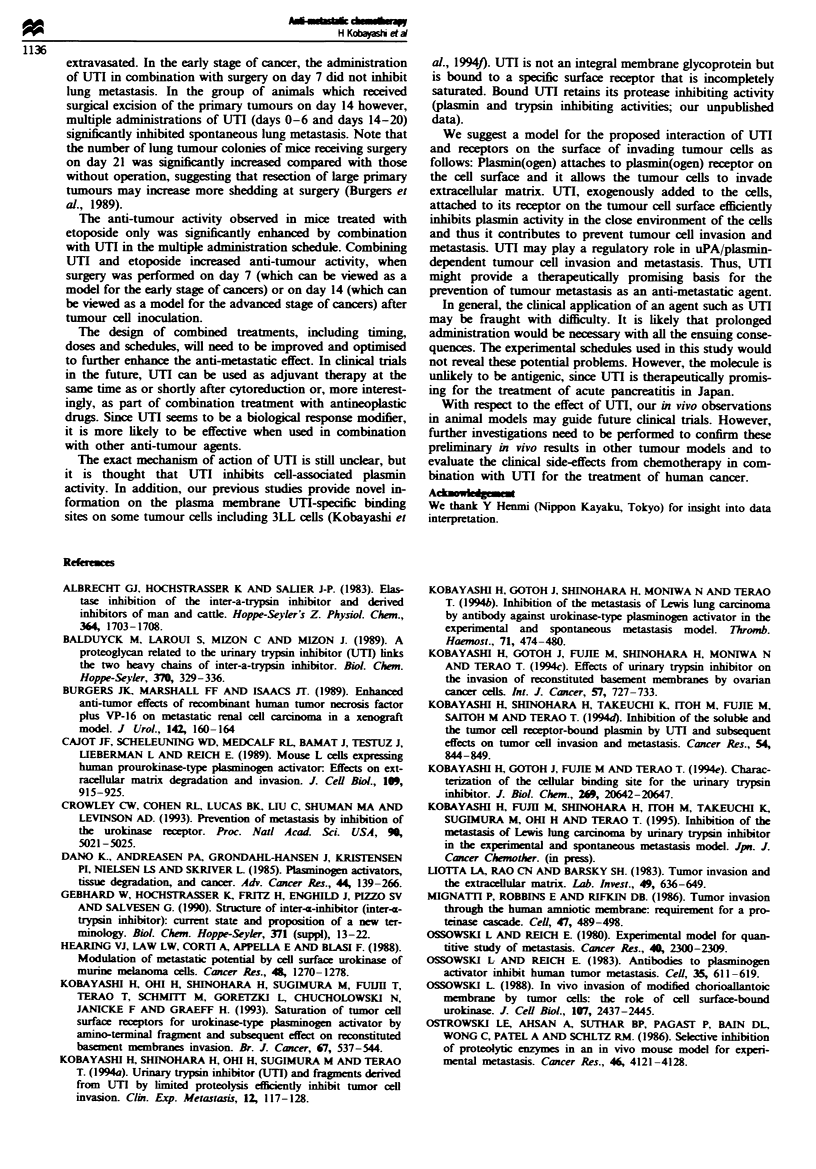Abstract
We have demonstrated that urinary trypsin inhibitor (UTI) purified from human urine is able to inhibit lung metastasis of mouse Lewis lung carcinoma (3LL) cells in experimental and spontaneous metastasis models. In this study, we have investigated whether UTI in combination with an anti-cancer drug, etoposide, can prevent tumour metastasis and show an enhanced therapeutic effect. Subcutaneous (s.c.) implantation of 3LL cells (1 x 10(6) cells) in the abdominal wall of C57BL/6 female mice resulted in macroscopic lung metastasis within 21 days. Microscopic lung metastasis was established by day 14 after tumour cell inoculation, and surgical treatment alone after this time resulted in no inhibition of lung metastasis. The number of lung tumour colonies in the group of mice which received surgery at day 21 was greater than in mice which had tumours left in situ (P = 0.0017). Surgical treatment on day 7, followed by UTI administration (s.c.) for 7 days, led to a decrease in lung metastasis compared with untreated animals. A significant inhibition of the formation of pulmonary metastasis was obtained with daily s.c. injections of UTI for 7 days immediately after tumour cell inoculation. UTI administration did not affect the primary tumour size at the time of operation. In addition, etoposide treatment alone led to a smaller primary tumours and yielded reduction of the formation of lung metastasis in the group of mice which received surgery at day 14 (P = 0.0026). Even in mice which received surgical treatment on day 14, followed by the combination of UTI (500 micrograms per mouse, days 14, 15, 16, 17, 18, 19 and 20) with etoposide (40 mg kg-1, days 14, 18 and 22), there was significant reduction of the formation of lung metastasis (P = 0.0001). Thus, the combination of an anti-metastatic agent with an anti-cancer drug, etoposide, might provide a therapeutically promising basis for anti-metastatic therapy.
Full text
PDF






Selected References
These references are in PubMed. This may not be the complete list of references from this article.
- Albrecht G. J., Hochstrasser K., Salier J. P. Elastase inhibition by the inter-alpha-trypsin inhibitor and derived inhibitors of man and cattle. Hoppe Seylers Z Physiol Chem. 1983 Dec;364(12):1703–1708. doi: 10.1515/bchm2.1983.364.2.1703. [DOI] [PubMed] [Google Scholar]
- Balduyck M., Laroui S., Mizon C., Mizon J. A proteoglycan related to the urinary trypsin inhibitor (UTI) links the two heavy chains of inter-alpha-trypsin inhibitor. Biol Chem Hoppe Seyler. 1989 Apr;370(4):329–336. doi: 10.1515/bchm3.1989.370.1.329. [DOI] [PubMed] [Google Scholar]
- Burgers J. K., Marshall F. F., Isaacs J. T. Enhanced anti-tumor effects of recombinant human tumor necrosis factor plus VP-16 on metastatic renal cell carcinoma in a xenograft model. J Urol. 1989 Jul;142(1):160–164. doi: 10.1016/s0022-5347(17)38703-7. [DOI] [PubMed] [Google Scholar]
- Cajot J. F., Schleuning W. D., Medcalf R. L., Bamat J., Testuz J., Liebermann L., Sordat B. Mouse L cells expressing human prourokinase-type plasminogen activator: effects on extracellular matrix degradation and invasion. J Cell Biol. 1989 Aug;109(2):915–925. doi: 10.1083/jcb.109.2.915. [DOI] [PMC free article] [PubMed] [Google Scholar]
- Crowley C. W., Cohen R. L., Lucas B. K., Liu G., Shuman M. A., Levinson A. D. Prevention of metastasis by inhibition of the urokinase receptor. Proc Natl Acad Sci U S A. 1993 Jun 1;90(11):5021–5025. doi: 10.1073/pnas.90.11.5021. [DOI] [PMC free article] [PubMed] [Google Scholar]
- Danø K., Andreasen P. A., Grøndahl-Hansen J., Kristensen P., Nielsen L. S., Skriver L. Plasminogen activators, tissue degradation, and cancer. Adv Cancer Res. 1985;44:139–266. doi: 10.1016/s0065-230x(08)60028-7. [DOI] [PubMed] [Google Scholar]
- Gebhard W., Hochstrasser K., Fritz H., Enghild J. J., Pizzo S. V., Salvesen G. Structure of inter-alpha-inhibitor (inter-alpha-trypsin inhibitor) and pre-alpha-inhibitor: current state and proposition of a new terminology. Biol Chem Hoppe Seyler. 1990 May;371 (Suppl):13–22. [PubMed] [Google Scholar]
- Hearing V. J., Law L. W., Corti A., Appella E., Blasi F. Modulation of metastatic potential by cell surface urokinase of murine melanoma cells. Cancer Res. 1988 Mar 1;48(5):1270–1278. [PubMed] [Google Scholar]
- Kobayashi H., Gotoh J., Fujie M., Terao T. Characterization of the cellular binding site for the urinary trypsin inhibitor. J Biol Chem. 1994 Aug 12;269(32):20642–20647. [PubMed] [Google Scholar]
- Kobayashi H., Gotoh J., Shinohara H., Moniwa N., Terao T. Inhibition of the metastasis of Lewis lung carcinoma by antibody against urokinase-type plasminogen activator in the experimental and spontaneous metastasis model. Thromb Haemost. 1994 Apr;71(4):474–480. [PubMed] [Google Scholar]
- Kobayashi H., Ohi H., Shinohara H., Sugimura M., Fujii T., Terao T., Schmitt M., Goretzki L., Chucholowski N., Jänicke F. Saturation of tumour cell surface receptors for urokinase-type plasminogen activator by amino-terminal fragment and subsequent effect on reconstituted basement membranes invasion. Br J Cancer. 1993 Mar;67(3):537–544. doi: 10.1038/bjc.1993.99. [DOI] [PMC free article] [PubMed] [Google Scholar]
- Kobayashi H., Shinohara H., Ohi H., Sugimura M., Terao T., Fujie M. Urinary trypsin inhibitor (UTI) and fragments derived from UTI by limited proteolysis efficiently inhibit tumor cell invasion. Clin Exp Metastasis. 1994 Mar;12(2):117–128. doi: 10.1007/BF01753978. [DOI] [PubMed] [Google Scholar]
- Kobayashi H., Shinohara H., Takeuchi K., Itoh M., Fujie M., Saitoh M., Terao T. Inhibition of the soluble and the tumor cell receptor-bound plasmin by urinary trypsin inhibitor and subsequent effects on tumor cell invasion and metastasis. Cancer Res. 1994 Feb 1;54(3):844–849. [PubMed] [Google Scholar]
- Liotta L. A., Rao C. N., Barsky S. H. Tumor invasion and the extracellular matrix. Lab Invest. 1983 Dec;49(6):636–649. [PubMed] [Google Scholar]
- Mignatti P., Robbins E., Rifkin D. B. Tumor invasion through the human amniotic membrane: requirement for a proteinase cascade. Cell. 1986 Nov 21;47(4):487–498. doi: 10.1016/0092-8674(86)90613-6. [DOI] [PubMed] [Google Scholar]
- Ossowski L. In vivo invasion of modified chorioallantoic membrane by tumor cells: the role of cell surface-bound urokinase. J Cell Biol. 1988 Dec;107(6 Pt 1):2437–2445. doi: 10.1083/jcb.107.6.2437. [DOI] [PMC free article] [PubMed] [Google Scholar]
- Ossowski L., Reich E. Antibodies to plasminogen activator inhibit human tumor metastasis. Cell. 1983 Dec;35(3 Pt 2):611–619. doi: 10.1016/0092-8674(83)90093-4. [DOI] [PubMed] [Google Scholar]
- Ossowski L., Reich E. Experimental model for quantitative study of metastasis. Cancer Res. 1980 Jul;40(7):2300–2309. [PubMed] [Google Scholar]
- Ostrowski L. E., Ahsan A., Suthar B. P., Pagast P., Bain D. L., Wong C., Patel A., Schultz R. M. Selective inhibition of proteolytic enzymes in an in vivo mouse model for experimental metastasis. Cancer Res. 1986 Aug;46(8):4121–4128. [PubMed] [Google Scholar]
- Reich R., Thompson E. W., Iwamoto Y., Martin G. R., Deason J. R., Fuller G. C., Miskin R. Effects of inhibitors of plasminogen activator, serine proteinases, and collagenase IV on the invasion of basement membranes by metastatic cells. Cancer Res. 1988 Jun 15;48(12):3307–3312. [PubMed] [Google Scholar]
- Saiki I., Yoneda J., Igarashi Y., Aoki M., Kusunose N., Ono K., Azuma I. Antimetastatic activity of polymeric RGDT peptides conjugated with poly(ethylene glycol). Jpn J Cancer Res. 1993 May;84(5):558–565. doi: 10.1111/j.1349-7006.1993.tb00176.x. [DOI] [PMC free article] [PubMed] [Google Scholar]
- Saiki I., Yoneda J., Kobayashi H., Igarashi Y., Komazawa H., Ishizaki Y., Kato I., Azuma I. Antimetastatic effect by anti-adhesion therapy with cell-adhesive peptide of fibronectin in combination with anticancer drugs. Jpn J Cancer Res. 1993 Mar;84(3):326–335. doi: 10.1111/j.1349-7006.1993.tb02874.x. [DOI] [PMC free article] [PubMed] [Google Scholar]
- Wachter E., Hochstrasser K. Kunitz-type proteinase inhibitors derived by limited proteolysis of the inter-alpha-trypsin inhibitor, IV. The amino acid sequence of the human urinary trypsin inhibitor isolated by affinity chromatography. Hoppe Seylers Z Physiol Chem. 1981 Oct;362(10):1351–1355. doi: 10.1515/bchm2.1981.362.2.1351. [DOI] [PubMed] [Google Scholar]


